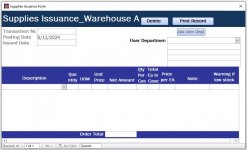hfsitumo2001
Member
- Local time
- Today, 00:44
- Joined
- Jan 17, 2021
- Messages
- 394
Hello, right now for our Inventory system, I have not found solution to the disability of MS Access to handle multi unit of measures. The way I do now is to create 2 Databases. For the big ware house I call it Warehouse A, where we receive supplies in cases, 1 database. And in the small warehouse, we call it Warehouse B, where we give the supplies to the user in " Single Unit", I call it "EA". So if the user take the supplies in CASES, I use Database Warehouse A, if the user take the supplies in single unit, I use Database Warehouse B. If the supplies in the small warehouse was low, I transfer from Warehouse A to Warehouse B, and I fill quantity field in the Warehouse A database as Out in CASE, and In Warehouse B, I fill in the input form the quantity in EA. say if 1 case consists of 6 rolls of paper towel, in Warehouse A database I put 1 CA as out, and I put 6 EA in Warehouse B database.
Any one can give me the sample of Multi Unit of Measure in only One database?
Thank you,
Frank
Any one can give me the sample of Multi Unit of Measure in only One database?
Thank you,
Frank

